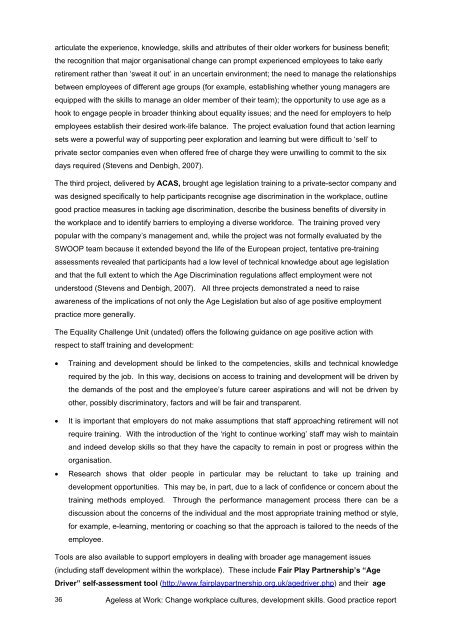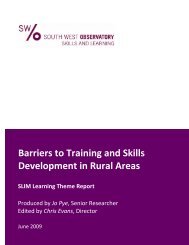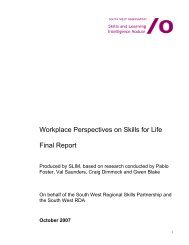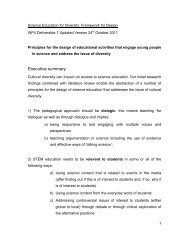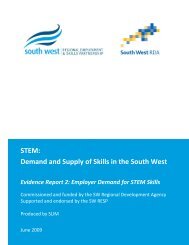Ageless at Work - Skills for Care
Ageless at Work - Skills for Care
Ageless at Work - Skills for Care
You also want an ePaper? Increase the reach of your titles
YUMPU automatically turns print PDFs into web optimized ePapers that Google loves.
articul<strong>at</strong>e the experience, knowledge, skills and <strong>at</strong>tributes of their older workers <strong>for</strong> business benefit;<br />
the recognition th<strong>at</strong> major organis<strong>at</strong>ional change can prompt experienced employees to take early<br />
retirement r<strong>at</strong>her than ‘swe<strong>at</strong> it out’ in an uncertain environment; the need to manage the rel<strong>at</strong>ionships<br />
between employees of different age groups (<strong>for</strong> example, establishing whether young managers are<br />
equipped with the skills to manage an older member of their team); the opportunity to use age as a<br />
hook to engage people in broader thinking about equality issues; and the need <strong>for</strong> employers to help<br />
employees establish their desired work-life balance. The project evalu<strong>at</strong>ion found th<strong>at</strong> action learning<br />
sets were a powerful way of supporting peer explor<strong>at</strong>ion and learning but were difficult to ‘sell’ to<br />
priv<strong>at</strong>e sector companies even when offered free of charge they were unwilling to commit to the six<br />
days required (Stevens and Denbigh, 2007).<br />
The third project, delivered by ACAS, brought age legisl<strong>at</strong>ion training to a priv<strong>at</strong>e-sector company and<br />
was designed specifically to help participants recognise age discrimin<strong>at</strong>ion in the workplace, outline<br />
good practice measures in tacking age discrimin<strong>at</strong>ion, describe the business benefits of diversity in<br />
the workplace and to identify barriers to employing a diverse work<strong>for</strong>ce. The training proved very<br />
popular with the company’s management and, while the project was not <strong>for</strong>mally evalu<strong>at</strong>ed by the<br />
SWOOP team because it extended beyond the life of the European project, tent<strong>at</strong>ive pre-training<br />
assessments revealed th<strong>at</strong> participants had a low level of technical knowledge about age legisl<strong>at</strong>ion<br />
and th<strong>at</strong> the full extent to which the Age Discrimin<strong>at</strong>ion regul<strong>at</strong>ions affect employment were not<br />
understood (Stevens and Denbigh, 2007). All three projects demonstr<strong>at</strong>ed a need to raise<br />
awareness of the implic<strong>at</strong>ions of not only the Age Legisl<strong>at</strong>ion but also of age positive employment<br />
practice more generally.<br />
The Equality Challenge Unit (und<strong>at</strong>ed) offers the following guidance on age positive action with<br />
respect to staff training and development:<br />
<br />
Training and development should be linked to the competencies, skills and technical knowledge<br />
required by the job. In this way, decisions on access to training and development will be driven by<br />
the demands of the post and the employee’s future career aspir<strong>at</strong>ions and will not be driven by<br />
other, possibly discrimin<strong>at</strong>ory, factors and will be fair and transparent.<br />
It is important th<strong>at</strong> employers do not make assumptions th<strong>at</strong> staff approaching retirement will not<br />
require training. With the introduction of the ‘right to continue working’ staff may wish to maintain<br />
and indeed develop skills so th<strong>at</strong> they have the capacity to remain in post or progress within the<br />
organis<strong>at</strong>ion.<br />
Research shows th<strong>at</strong> older people in particular may be reluctant to take up training and<br />
development opportunities. This may be, in part, due to a lack of confidence or concern about the<br />
training methods employed. Through the per<strong>for</strong>mance management process there can be a<br />
discussion about the concerns of the individual and the most appropri<strong>at</strong>e training method or style,<br />
<strong>for</strong> example, e-learning, mentoring or coaching so th<strong>at</strong> the approach is tailored to the needs of the<br />
employee.<br />
Tools are also available to support employers in dealing with broader age management issues<br />
(including staff development within the workplace). These include Fair Play Partnership’s “Age<br />
Driver” self-assessment tool (http://www.fairplaypartnership.org.uk/agedriver.php) and their age<br />
36<br />
<strong>Ageless</strong> <strong>at</strong> <strong>Work</strong>: Change workplace cultures, development skills. Good practice report


